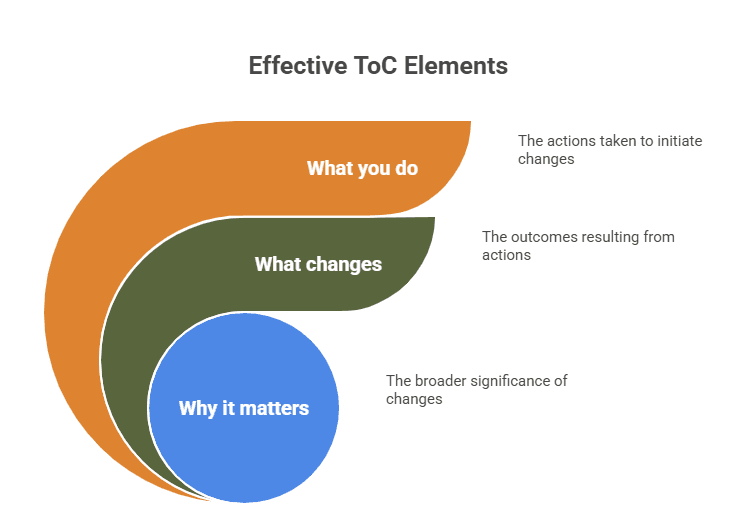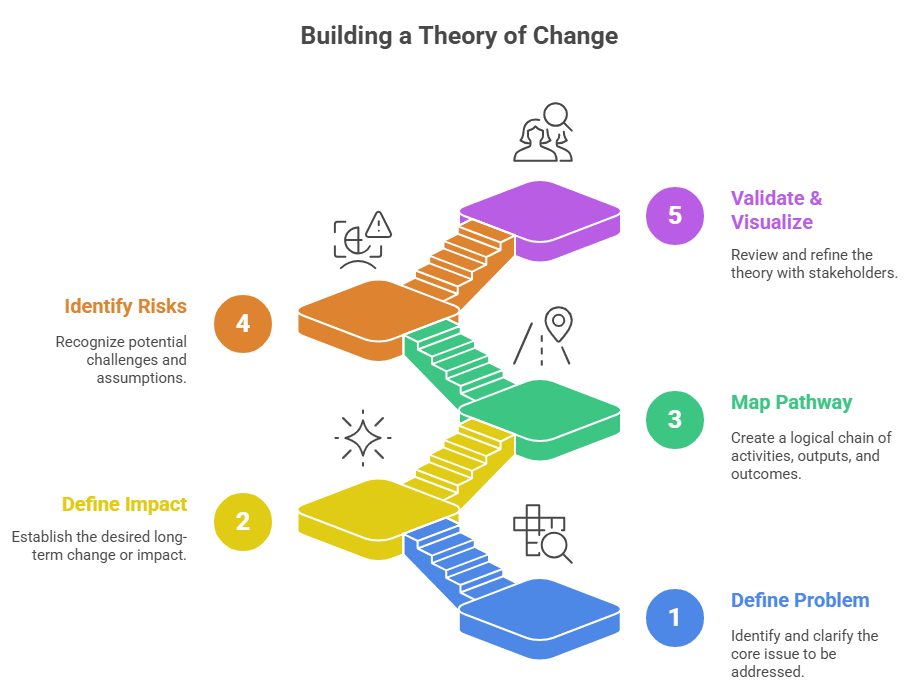The Real Problem!
Let’s be honest — most “Theories of Change” look impressive on PowerPoint, but when you ask the team what it actually means, there’s silence.
Too many proposals fail not because the idea was weak, but because the logic wasn’t clear. Donors face confusion and are reluctant to provide funds.
Most proposals fail at the Theory of Change (ToC) stage, not because the idea is weak, but because the logic is unclear.
If your Theory of Change can’t explain in 60 seconds how your project’s activities lead to real outcomes, it’s not working for you.
Here’s how to fix that.
What a Strong Theory of Change Really Does?
A strong ToC isn’t a donor requirement — it’s your project’s backbone.
It helps you:
- Align your team on one shared vision.
- Show donors you understand the pathway to impact.
- Make monitoring and evaluation simple later.
In short, a good ToC connects three things:
What you do → What changes → Why it matters.

The 5 Steps to Build a Theory of Change That Works
Let’s break it down into something you can actually use in your next proposal.
Step 1: Start with the Problem You’re Solving
Define one clear issue. Not ten.
Ask: What is happening, to whom, and why does it matter?
Use data and field evidence. Example: “Adolescent girls in rural areas lack access to safe learning spaces due to early marriage and social restrictions.”
Tip: If your problem statement sounds like a slogan, it’s too vague. Make it real and measurable.
Step 2: Define the Long-Term Change You Want
This is your impact — the “north star” that guides everything else.
Ask: What lasting change do we want to see if our project succeeds completely?
Example: “Girls are completing secondary education and contributing to community development.”
Be bold but realistic — it should be achievable in the long run, not just within one project cycle.

Step 3: Map the Pathway of Change (the Logic Chain)
Here’s where you draw the cause-and-effect pathway.
Start backward from your impact:
- What outcomes must happen first?
- What outputs lead to those outcomes?
- What activities create those outputs?
Example:
- Activities: Conduct community awareness sessions on girls’ education. Sessions with caregivers or parents and meeting with communtiy leaders and school management committee.
- Outputs: Increased parental and communtiy support for girls’ schooling.
- Outcomes: Higher school attendance and reduced dropouts.
- Impact: More girls completing secondary education.
Visualize this as a flowchart — donors love clarity over decoration.
Step 4: Identify Assumptions and Risks
This step separates a professional ToC from a copy-paste one.
Ask:
- What must stay true for our logic to work?
- What external factors could block it?
Example: Assumption: Local schools have enough teachers and facilities. Risk: Social pressure might still discourage attendance.
State these clearly — it shows maturity in design thinking.
Step 5: Validate and Visualize
Don’t finalize your ToC alone.
Review it with community members, technical staff, and monitoring experts. If they can’t explain it easily, it’s not ready.
Keep it one page. Simplicity sells clarity.
Action: What to Do Next
Before you send your next proposal, take one hour to rebuild your Theory of Change using these five steps.
It’s not about looking sophisticated — it’s about being convincing.
A strong ToC shows donors that you understand how change really happens, not just how to fill templates.

